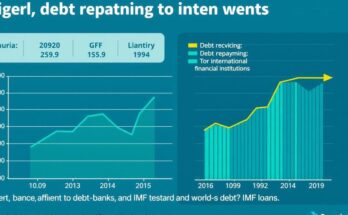President Trump announced 25% tariffs on Mexico and Canada, effective immediately, despite both nations’ efforts to reduce illegal migration and drug trafficking. The decision has caused stock market declines and could lead to increased consumer prices. Both Mexico and Canada consider retaliatory tariffs if the U.S. proceeds with these measures, reflecting ongoing tensions in trade policy.
On Monday, President Donald Trump announced new 25% tariffs on exports from Mexico and Canada, initiated at midnight. This decision comes despite evidence suggesting that both countries have made efforts to reduce illegal migration and drug trafficking into the United States. The President stated, “The tariffs, you know, they’re all set,” indicating the swift activation of these measures.
As a result of the tariff announcement, all major U.S. stock indexes experienced significant declines shortly before market close. The tariff increases are expected to impact trade among the U.S., Mexico, and Canada, potentially decreasing American demand for goods from these neighboring countries due to higher prices, thus affecting consumers and businesses alike.
Responses from both countries remain uncertain; however, leaders in Mexico and Canada, including President Claudia Sheinbaum and Prime Minister Justin Trudeau, hinted at retaliatory measures against U.S. exports should Trump proceed with the tariffs. Previously, Trump delayed the imposition of these tariffs after discussions regarding border control measures to combat illegal migration and drug trafficking.
U.S. Commerce Secretary Howard Lutnick noted that while illegal crossings are at a historic low, there remains concern over drug trafficking, specifically fentanyl. He stated, “The Mexicans and the Canadians have done a nice job on the borders,” highlighting ongoing challenges. This reflects a nuanced situation where the President acknowledges improvements but believes more action is necessary.
In tandem with tariffs on Mexico and Canada, Trump plans to introduce a 10% tariff on Chinese goods, effectively doubling rates established earlier this year. This broader initiative stems from his view of China as a primary contributor to fentanyl trafficking within the United States.
Following Trump’s initial tariff announcements, Mexico deployed 10,000 troops to its northern border to manage narcotics flows, while Canada appointed a “fentanyl czar” to enhance border security and deal with trafficking issues. Both nations aim to address the drug crisis amid rising tensions with the U.S.
Sheinbaum has expressed hope for a negotiated settlement with the U.S. before tariffs take effect, warning that retaliatory tariffs could be imposed on American exports if no compromise is reached. Similarly, Trudeau criticized the tariffs as “entirely unjustified” and pledged to implement a 25% tax on U.S. steel and aluminum products exported to Canada, given that these materials are among the top exports from Canada.
Economists predict the tariffs will contribute to escalating retail prices for American consumers and increased operational costs for U.S. businesses. Within the context of international trade, Mexico, Canada, and China represent the United States’ three largest trading partners, with the European Union as a larger collective trading entity.
Trump has indicated that additional tariffs could be announced, including a potential 25% tariff on EU exports to the U.S., prompting a commitment from the EU to respond robustly to any unforeseen trade barriers. The President suggests that these tariffs encourage foreign firms to manufacture domestically to bypass import levies, aiming to bolster the U.S. economy.
In summary, President Trump’s imposition of new tariffs on Mexico and Canada is part of a broader trade strategy aimed at addressing illegal migration and drug trafficking issues. The potential economic fallout could affect consumer prices and business costs while inviting retaliatory measures from neighboring countries. The unfolding situation underscores the complexities of international trade relations and domestic economic implications in the U.S.
Original Source: www.voanews.com




